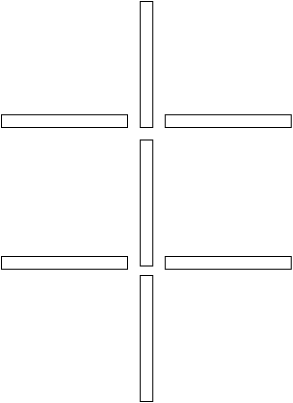Both the snowflake curve and the fractal cuboids are composed of a simple sequence of symbols: The turtle reads this sequence from left to right and draws the corresponding objects. Thus, we see a set of three-dimensional objects which are stringed together one after another.
While this is sufficient for very simple structures, it would not be feasible to model more complex structures this way. For example, the side branches of plants and trees cannot be represented easily within a single sequence of symbols: At every branching, a new sequence for the side branch starts, while the bearing branch continues with its own sequence of symbols.
As an example,
consider the following two figures: The left one
shows a structure consisting of a quite abstract stem (three
consecutive elements) and four side branches (each a single element).
The stem is representable by the sequence
F F F of turtle commands. Each branch is
representable by the single turtle command F,
and the branching rotations can be encoded by RU
commands.
 Stem with four branches |
 Internal graph structure using turtle commands |
The figure on the right hand side shows a graph which combines the turtle commands of the stem and its branches into a single structure. The graph has to be understood as follows:
Each symbol (e.g.,
F,RU) is a node of the graph.Nodes are connected by directed edges (the arrows in the figure).
The direction of edges reflects the direction in which the turtle executes its commands.
Branchings occur at a node when there are two or more edges starting at the node. In this case, the turtle handles each branch separately and independently.
Now relational growth grammars use a textual notation for branches with the help of square brackets: Each branch is included in a pair of square brackets and appended behind its bearing symbol. E.g., the graph in the figure above is written textually as
F [RU(90) F] [RU(-90) F] F [RU(90) F] [RU(-90) F] F
The three F's of the stem can be seen when
ignoring the bracketed parts. In order to see that this works, click
here
and have a look at the source code in the text editor and at the
3D view.
This very simple example of branched structures has no development,
it just creates a fixed structure. But there is a second,
more interesting example of branching with a simple
development: In every step of development, an
F segment is split into two
F segments, and two side branches are
created at the splitting location.